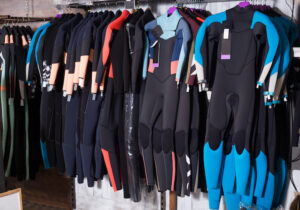Are you passionate about water sports like surfing, swimming, paddling, or diving? Then, ensuring proper protection in wet conditions should be your top priority. When venturing into waters cooler than 25 degrees Celsius, the right gear becomes essential, as your body can lose heat rapidly without it.
Exposure suits are designed to shield you from significant heat loss when you’re in the water. Both wetsuits and drysuits play a crucial role in helping your body maintain a comfortable temperature, whether you’re diving or swimming. Additionally, they offer protection against harmful UV rays from the sun.
Feeling unsure about whether to choose a wetsuit or a drysuit? Read on to explore the features of both types of suits and understand the key differences between them.
In this article, you will get answers to the following questions:
- What are the main differences between a wetsuit and a drysuit?
- Which suit provides better insulation in cold water conditions?
- How does each suit affect freedom of movement during water sports?
- What are the advantages of wearing a drysuit versus a wetsuit for specific water sports?
- How do wetsuits and drysuits differ in terms of maintenance and durability?
Wetsuit vs. Drysuit: Which One Should You Choose?
When it comes to water sports and outdoor activities in cold or temperate waters, the choice between a wetsuit and a drysuit is crucial. Both serve to protect your body from the cold and the elements, but they function in very different ways.
How Do Wetsuits Work?
Understanding how wetsuits work is the first step to knowing which type of suit will suit your personal needs best. Wetsuits are made from neoprene, a stretchy, water-resistant material that provides insulation by trapping a thin layer of water between your body and the suit.
Once your body warms this trapped water, it acts as a thermal barrier, helping to keep you warm in cold water. The snug fit of a wetsuit ensures that only a small amount of water enters the suit, so your body heat isn’t lost to the surrounding environment.
Attention!
You want to dive deeper into the question, whether a wetsuit keeps you dry? Check out our article about the topic to learn more.Wetsuits come in various wetsuit thicknesses, typically ranging from 2mm to 7mm, depending on the water temperature. The thicker the suit, the better it insulates, though thicker wetsuits can also feel bulkier.
Wetsuits are commonly used in sports like surfing, kitesurfing, and open-water swimming, where flexibility and freedom of movement are key. They are effective in water temperatures ranging from about 10°C to 25°C. However, in colder waters below 10°C, even the thickest wetsuit may not provide sufficient warmth.
Practicing in icy water leads to two options. Option No. 1: Wearing underwear underneath your wetsuit, or Option No. 2: Choosing a Drysuit.
How Does a Drysuit Work?
Unlike wetsuits, drysuits are designed to keep you completely dry by sealing off water at the neck, wrists, and ankles. These watertight seals ensure that no water enters the suit, and instead of relying on water for insulation, drysuits trap a layer of air around your body.
You can also wear thermal layers underneath the drysuit for added warmth. Drysuits are often made from materials like trilaminate or vulcanized rubber, which are durable and provide excellent waterproofing.
Drysuits are ideal for activities in icy water, often below 10°C. They are frequently used in scuba diving, kayaking, sailing, or any activity where extended exposure to cold water is expected.
Because drysuits keep you completely dry, they offer superior thermal protection over long periods in frigid conditions. However, they tend to be bulkier than wetsuits, which can restrict movement and make them less suitable for high-intensity activities like surfing or especially kitesurfing.
The Difference between Wetsuit and Drysuit
When deciding between a wetsuit and a drysuit, it’s important to understand their key differences and how each one functions. Both are designed to keep you warm in cold water, but they do so in completely different ways.
A wetsuit works by trapping a thin layer of water against your body, which your natural heat warms up. In contrast, a drysuit keeps you entirely dry by sealing out water, allowing you to wear thermal layers underneath for insulation.
But that is not at all everything. Besides the obvious dry vs. wet part, the two suits differ in much more points, starting with their flexibility, their costs and also their durability.
Comparing Flexibility and Mobility
One of the key differences between wetsuits and drysuits is flexibility. Wetsuits are designed to fit snugly against your body, allowing for a full range of motion. The neoprene material is stretchy, making wetsuits an excellent choice for dynamic sports like surfing, kitesurfing, and wakeboarding. These sports require rapid movement and agility, and a wetsuit’s flexibility ensures that you can move freely without feeling restricted.
Drysuits, while excellent for warmth and protection, are less flexible than wetsuits. The bulkier material and air trapped inside can make movement feel more cumbersome, especially when wearing additional thermal layers.
For activities that require frequent motion or quick manoeuvres, like paddling or kiteboarding, the extra bulk of a drysuit can feel restrictive. If maximum mobility is essential for your sport, a wetsuit is likely the better option.
Which Is Warmer: Wetsuit or Drysuit?
When it comes to staying warm, the choice between a wetsuit and a drysuit depends largely on the water temperature and duration of your activity. In moderate to cold water above 10°C, a wetsuit offers sufficient insulation for shorter activities, especially if you’re in and out of the water frequently.
In colder waters below 10°C, however, a drysuit is the clear winner. By keeping you completely dry and allowing for additional insulation layers underneath, drysuits provide superior warmth. This makes them the preferred choice for cold-water diving, kayaking, or other activities where you’re exposed to icy water for extended periods. If warmth and dryness are your top priorities, especially in freezing conditions, a drysuit is the best option.
Durability and Maintenance
Both, wetsuits and drysuits, require proper care to maintain their performance and longevity, but their durability and maintenance needs differ. Adding a 5 minutes maintenance routine after each water session can make a huge difference in the lifespan of your suit.
Attention!
Learning how to wash a wetsuit or a drysuit properly and dry it well can not only help you prevent an early end to the wetsuit’s life, but also keeps it from causing you a wetsuit rash.Wetsuits are generally more prone to wear and tear due to their stretchy neoprene material, which is regularly exposed to saltwater, sun, and friction from boards or other equipment. Wetsuits should be rinsed with fresh water after each use, dried out of direct sunlight, and stored flat or hung on a wide hanger to avoid creasing.
With proper care, a wetsuit can last for several seasons, though heavy use in rough conditions may shorten its lifespan.
Drysuits are built for more rugged environments and tend to be more durable, especially in cold and harsh water conditions. However, the seals around the neck, wrists, and ankles are delicate and require regular inspection and maintenance.
Drysuits also need to be checked for leaks periodically. Given their higher cost, drysuits are an investment that requires careful upkeep, but they tend to last longer than wetsuits when properly maintained.
Drysuit vs. Wetsuit Costs – What to Expect
When comparing drysuits and wetsuits, one of the key factors to consider is the price. Both serve different functions, and their costs reflect their design, materials, and intended use.
Wetsuits are generally more affordable than drysuits, with a wide range of prices based on the brand, material quality, thickness, and design.
Here’s a general idea of wetsuit price ranges:
- Entry-Level Wetsuits: $50 – $150
These are typically thinner suits made from standard neoprene and ideal for warmer waters or casual water activities. - Mid-Range Wetsuits: $150 – $300
Offering better flexibility and durability, these wetsuits usually feature more advanced neoprene and additional features like sealed seams for improved insulation. - High-End Wetsuits: $300 – $600+
High-end wetsuits use premium materials like Yamamoto neoprene or other ultra-stretch materials for optimal performance and warmth. They often include advanced thermal lining, better seals, and specialized cuts for specific sports like surfing or kitesurfing.
Drysuits tend to be significantly more expensive due to their construction and the materials needed to keep the wearer completely dry.
Here’s what you can expect:
- Entry-Level Drysuits: $500 – $1,000
Basic drysuits often use materials like nylon or trilaminate with latex seals. These suits offer solid protection in colder waters, but may lack some of the advanced features of higher-end models. - Mid-Range Drysuits: $1,000 – $1,500
These drysuits are built with more durable materials and often include features like adjustable seals, reinforced knees, and better waterproof zippers. They’re suitable for more demanding water sports like diving or cold-weather kayaking. - High-End Drysuits: $1,500 – $3,000+
At the high end, drysuits are designed for extreme conditions and often include custom sizing, advanced breathable fabrics like Gore-Tex, and high-performance seals. These suits are typically used by professionals or enthusiasts in cold climates or extreme sports.
Making the Right Choice: Drysuit vs. Wetsuit
Ultimately, the choice between a drysuit and a wetsuit depends on the conditions you’ll be facing and your own comfort level in the water. If you’re kitesurfing or diving in extremely cold waters, a drysuit might offer better protection. However, for more moderate temperatures and a greater range of motion, a wetsuit could be the ideal option. Consider your activity, climate, and how much insulation you require to make the best decision.
When Should You Choose a Wetsuit?
A wetsuit is ideal for activities in temperate or cold water where flexibility, comfort, and freedom of movement are important. Sports like surfing, kitesurfing, and wakeboarding benefit from the lightweight and stretchy nature of a wetsuit.
You should opt for a wetsuit if:
- The water temperature is above 10°C
- You need flexibility and mobility for dynamic sports
- You’ll be frequently in and out of the water
- You prefer a snug, form-fitting design that doesn’t restrict movement
When Should You Choose a Drysuit?
A drysuit is best suited for environments where staying dry and warm is crucial, especially in freezing water. Drysuits are ideal for activities like cold-water diving, sailing, or long kayaking trips, where prolonged exposure to freezing temperatures is expected.
Choose a drysuit if:
- The water temperature is below 10°C (50°F)
- You need maximum insulation and warmth for extended periods
- Staying dry is essential for your safety or comfort
- You are prepared to invest in regular maintenance
Drysuit vs. Wetsuit in Different Sports
When choosing between a drysuit and a wetsuit, the decision often depends on the type of water sport you’re engaged in. Both suits serve to protect the wearer from cold water, but they are better suited to different activities based on their design and functionality.
Here’s a closer look at how they compare across various water sports:
1. Diving
For diving, especially in cold waters, a drysuit is generally preferred. Drysuits create a watertight seal, keeping you completely dry, which is crucial when diving in extremely cold conditions. They offer greater thermal insulation because you can wear layers underneath, making them ideal for prolonged dives. Wetsuits, on the other hand, are suitable for warmer waters and shorter dives where flexibility is important.
2. Kitesurfing
Kitesurfers often opt for wetsuits because of their flexibility and freedom of movement. Wetsuits provide enough insulation while still allowing dynamic body motions needed for manoeuvres and tricks. In colder climates, some kitesurfers may use drysuits for added warmth, but the bulkiness can sometimes limit agility on the board.
3. Swimming
For swimming, wetsuits are almost always the preferred option. A wetsuit not only provides warmth but also offers buoyancy, which can enhance performance in open water. Drysuits are generally not recommended for swimming because they are too bulky and restrict movement, making it difficult to swim efficiently. In most cases, swimmers in colder water will opt for a thicker wetsuit for protection and freedom of movement.
4. Surfing
Surfers typically favour wetsuits, as they offer a perfect balance of warmth and flexibility. Since surfers are constantly in and out of the water, a wetsuit allows for quick drying while still maintaining flexibility to perform tricks and manoeuvres. Drysuits are rarely used for surfing, as they can feel cumbersome and restrictive.
5. Kayaking
Kayakers who paddle in cold waters often prefer drysuits, as they protect against not only water but also windchill. Since kayakers aren’t fully submerged but face cold water splashes, staying dry is important. Wetsuits can also be worn, but may not offer as much protection from cold air and water as a drysuit would.
Conclusion: Drysuit vs. Wetsuit – Your Personal Winner
Deciding between a wetsuit and a drysuit comes down to the specific conditions and the type of water sport you plan to engage in. For moderate water temperatures and activities that require agility and flexibility, a wetsuit offers the perfect balance of warmth, comfort, and mobility. However, if you’re venturing into extremely cold waters or spending long hours immersed in freezing temperatures, a drysuit is your best bet for staying warm, dry, and protected. Whether you’re catching waves, diving as deep as humanly possible, or navigating icy rivers, your wetsuit or drysuit will be your most important gear on the water.
FAQ – Most asked questions
A drysuit is typically warmer, as it prevents water from entering and can be layered with insulating clothing, making it ideal for colder conditions.
Drysuits are not ideal for swimming due to their bulk and limited flexibility. Wetsuits are better suited for swimming as they offer better mobility and buoyancy.
Both can be durable if properly maintained, but drysuits may require more care due to their seals and zippers, which can be more prone to wear and tear.
Wetsuits dry faster on the outside, but the inside takes longer due to the water trapped in the material. Drysuits dry quicker overall since they don’t let water in.
Generally, drysuits tend to be more expensive than wetsuits due to their more complex design and materials used for waterproofing and insulation.









